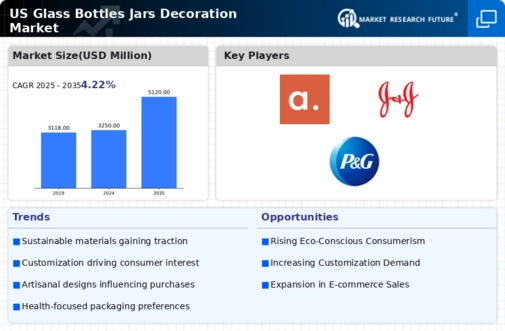Growth of the Craft Beverage Sector
The craft beverage industry, encompassing craft beers, artisanal spirits, and specialty juices, is experiencing robust growth, which positively influences the glass bottles-jars-decoration market. In 2025, the craft beer market alone is anticipated to surpass $30 billion, with a substantial portion of these beverages packaged in glass bottles. This trend is driven by consumer preferences for quality and authenticity, leading to an increased demand for aesthetically pleasing glass packaging. The glass bottles-jars-decoration market is poised to capitalize on this growth, as craft beverage producers often prioritize unique and decorative glass containers to enhance brand identity. As the craft beverage sector continues to expand, the demand for innovative glass packaging solutions is likely to rise, further propelling the market.
Regulatory Support for Glass Packaging
Regulatory frameworks promoting the use of recyclable materials are favorably impacting the glass bottles-jars-decoration market. Governments are increasingly implementing policies aimed at reducing plastic waste, which encourages businesses to adopt glass packaging solutions. In 2025, it is estimated that 70% of consumers will prefer brands that utilize recyclable materials, including glass. This regulatory support is likely to enhance the glass bottles-jars-decoration market, as companies seek to comply with environmental standards while appealing to eco-conscious consumers. Furthermore, incentives for using sustainable packaging materials may lead to increased investments in glass production, fostering innovation and growth within the market. As regulations evolve, the demand for glass packaging is expected to rise, positioning the industry for long-term success.
Consumer Preference for Premium Products
There is a noticeable shift in consumer behavior towards premium products, which is influencing the glass bottles-jars-decoration market. As disposable income rises, consumers are increasingly willing to invest in high-quality, aesthetically pleasing packaging. This trend is particularly evident in sectors such as cosmetics and gourmet food, where glass packaging is often associated with luxury and quality. In 2025, the premium packaging market is expected to grow by 6%, with glass bottles and jars playing a pivotal role. The glass bottles-jars-decoration market is likely to thrive as brands leverage this consumer preference to differentiate themselves through unique and decorative glass packaging. This inclination towards premium products not only enhances brand perception but also drives sales in various sectors.
Rising Demand for Eco-Friendly Packaging
The increasing consumer preference for sustainable products is driving the glass bottles-jars-decoration market. As environmental concerns gain traction, manufacturers are responding by producing eco-friendly glass packaging solutions. In 2025, the market for sustainable packaging is projected to reach $500 billion, with glass bottles and jars accounting for a significant share. This shift towards sustainability not only aligns with consumer values but also encourages brands to adopt glass as a primary packaging material. The glass bottles-jars-decoration market is likely to benefit from this trend, as consumers increasingly seek products that minimize environmental impact. Furthermore, regulatory pressures aimed at reducing plastic waste are expected to bolster the demand for glass packaging, making it a preferred choice for many businesses.
Technological Advancements in Glass Manufacturing
Innovations in glass manufacturing technology are significantly impacting the glass bottles-jars-decoration market. Advanced production techniques, such as automated glass forming and improved melting processes, have enhanced efficiency and reduced costs. In 2025, the glass manufacturing sector is projected to grow at a CAGR of 4.5%, driven by these technological advancements. The glass bottles-jars-decoration market stands to benefit from increased production capabilities, allowing for more intricate designs and customization options. Additionally, these advancements may lead to lighter and more durable glass products, appealing to both manufacturers and consumers. As technology continues to evolve, the market is likely to see a surge in demand for innovative glass packaging solutions that meet the needs of diverse industries.














Leave a Comment